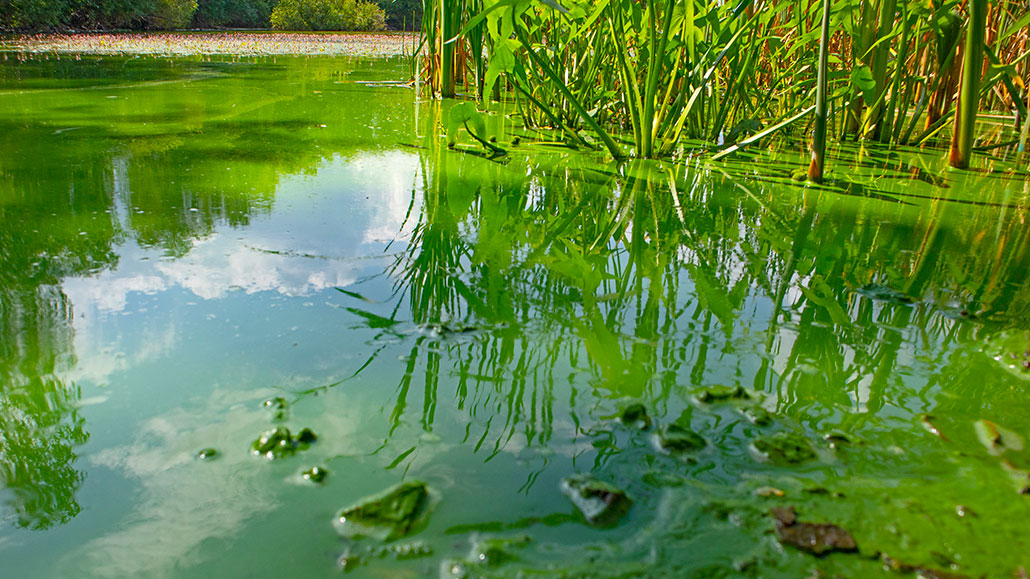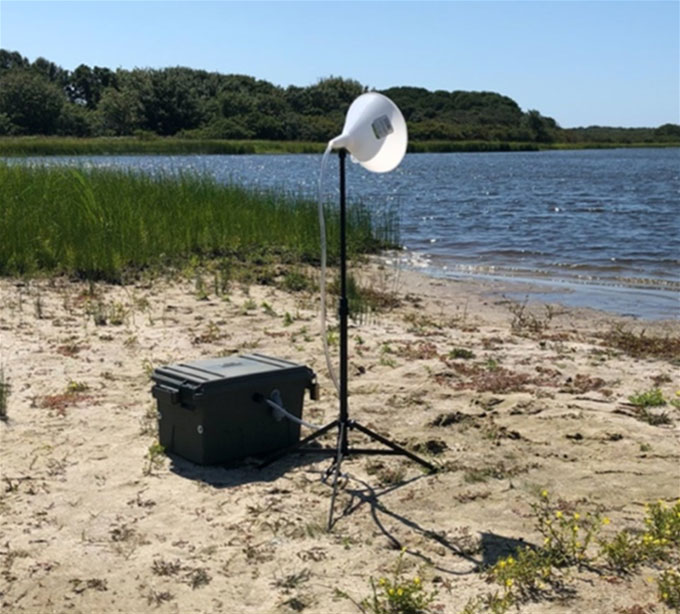Pond scum can release a paralyzing pollutant into the air
When blooms of blue-green algae overgrow a pond, the results can be deadly

Overgrowth of cyanobacteria — the blue-green algae coloring the water here — can release toxic pollution, making this water dangerous to animals and people.
Marvod/iStock/Getty Images Plus
Share this:
- Share via email (Opens in new window) Email
- Click to share on Facebook (Opens in new window) Facebook
- Click to share on X (Opens in new window) X
- Click to share on Pinterest (Opens in new window) Pinterest
- Click to share on Reddit (Opens in new window) Reddit
- Share to Google Classroom (Opens in new window) Google Classroom
- Click to print (Opens in new window) Print
The summer sun warms the still surface of a pond on Nantucket Island in Massachusetts. This water contains fertilizer that had washed off of a nearby farm during a storm. In the warm water, cyanobacteria gorge themselves on nutrients from that fertilizer. Soon, their abundance mushrooms into a “bloom.” These bacteria can release a toxin that poisons the air, a study now shows.
People often call these bacteria blue-green algae even though they aren’t algae at all. Much as plants do, these bacteria use sunlight to turn carbon dioxide into food. Along the way, they burp out oxygen as waste. In fact, cyanobacteria were among the first living things on Earth. They helped fill our early atmosphere with oxygen.
But fed too many nutrients, cyanobacteria can grow out of control. These freshwater blooms may look like scum, foam, mats or even paint floating atop the water. A warming climate and the growing use of fertilizers has upped the number of so-called algal blooms.
A number of different aquatic microbes can release toxins. Freshwater microbes are to blame for most people and animals in the United States that are sickened by such aquatic blooms. That’s according to December 2020 report by a team of government scientists. They described data on 421 toxic blooms over a three-year period that ended in 2018. Fully 30 of the water samples in which toxins had been identified by type — 10 percent — contained anatoxin-a. Also known as ATX, it’s the natural poison made by cyanobacteria.
Scientists knew ATX could poison pond water. The question was whether it also could get into the air.
Human poisonings tend to occur after people walk through tainted water. Exposure to ATX can make someone sleepy or numb. Their muscles might twitch. It also could make it hard to breathe as it paralyzes the respiratory system. Birds, cows and dogs may even die after swallowing water tainted by blooms. ATX is deadly enough that it’s often called Very Fast Death Factor.
Capturing poison
James Sutherland is part of a team that has studied ponds on Nantucket Island for several years. An ecologist in Greenwich, N.Y., he works with the Nantucket Land Council. Harmful blooms show up on a few ponds every summer and early fall, his team has found. His group knew the pond scum responsible could release toxins that might enter the air. To see if ATX could do this, they used an experimental air sampler.
Windy and rainy days offered ATX the best chance of entering the air, they suspected. The reason: Sunlight quickly breaks down droplets of ATX in the air. And that would make the toxin hard to capture.
So they placed the air sampler on the shore of a small pond during a bloom of pond scum. Later, the team analyzed what the air sampler had collected in its filter. ATX turned up in samples on one day. And on that day, Sutherland notes, “a dense fog occurred.” He suspects that may have kept the ATX from breaking down.

“This was the first time that the capture of airborne ATX has been reported,” Sutherland says. His group shared its findings April 1 in Lake and Reservoir Management.
“We believe that ATX is more of an airborne pollutant problem than previously thought,” Sutherland now says. And that’s worrisome, he adds, “given the world-wide increase in blooms of aquatic algae and bacteria. The seriousness of airborne toxins as a health risk should not be taken lightly.”
“This study raises an important issue,” especially near water with high levels of anatoxin, says Ellen Preece. She’s a cyanobacteria expert who did not take part in the Nantucket study. She works for a consulting firm in Rancho Cordova, Calif.
The Nantucket team did not investigate how ATX entered the air. They also don’t know how much must be breathed in to sicken someone. But, Sutherland says, “We intend to continue studying the problem.” Such studies could prove especially useful, Preece says, “as we see harmful algal blooms continue to increase.”







